BBC Pop Up: Behind the scenes in Tucson
- Published
- comments

Welcome to BBC Pop Up.
The BBC's first mobile bureau is spending a month in each of six very different parts of the US. We want Americans to tell us what local stories we should share with a global audience. We've created a behind-the-scenes blog so we can tell you not only what we're up to, but also explain why and how we're doing it. Please get in touch with your story ideas and comments on the project.
This month the Pop Up team is in Tucson, Arizona. Lindsay Patross is documenting their adventures for this blog.
(We've reopened the comments on 23 January and will continue to leave them open for your to share your thoughts on Tucson)

Can scientists believe in God?
13 February, 2015
Vatican Arizona
The central aim of BBC Pop Up is to discover stories we would have been unlikely to come across without spending time on the ground talking to people. Even so, it was still a shock to unearth a tale as surprising as the Jesuit astrophysicists.
During our month-long stay in Arizona in January, we received several emails from locals suggesting we examine astronomy in the region. That made sense because the mountains in the desert outside Tucson are considered a perfect spot to study the stars from.
But until locals told us about the Vatican Observatory we had absolutely no idea that the Catholic Church has its own team of priests using large telescopes to search for other inhabitable worlds.
Watch the video to hear from two of the priests with advanced degrees in astrophysics and astronomy - as well as from an atheist scientist who challenges whether the best scientists can believe in God too. Tell us what you think.
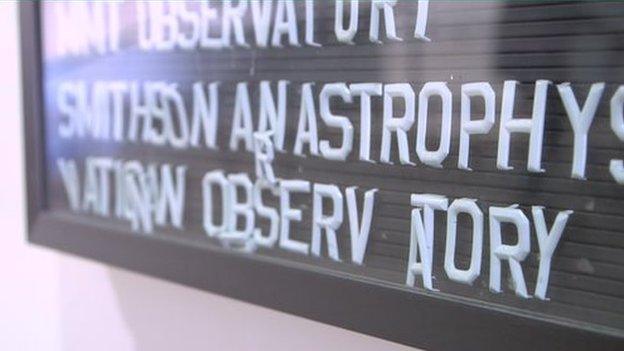
I thought it would be interesting to have a little extra background on how the Vatican Observatory ended up in the mountains near Tucson.
The Observatory traces its roots back to a committee in 1582 that was established by Pope Gregory XII and tasked with gathering data related to the reform of the calendar. It was this research into data surrounding the passage of days and months that led to an interest in the revolving stars in the sky.

Three observatories were originally established, but Pope Leo XII formally re-founded the Vatican Observatory in 1891 on a hillside behind the dome of St Peter's Basilica in Vatican City. The institute was in part founded to "counteract longstanding accusations of hostility of the Church towards science", according to the Vatican Observatory's website.
But by the 1930s, the ever-growing light pollution from Rome had made it impossible for the Church's astronomers to do their research from the group's existing facilities. After first moving the Observatory further south in Italy, the Vatican Observatory Research Group was created and since 1981 had been based at the Steward Observatory at the University of Arizona in Tucson.

Cowtown Keeylocko: A One-Man Town south of Tucson
1 February, 2015
BBC Pop Up visits a cow town
A few days ago we ventured out into the desert about 45 minutes southwest of Tucson to film some views of the Kitt Peak National Observatory (stay tuned for our story on religion and science in the desert).
After a chance conversation with a local resident, we ended up in the town that Ed Keeylocko built. Check out our tour of Cowtown Keeylocko and keep reading for more about our visit.
On our way back to Tucson we made a few stops to film some cacti and other desert landscapes.
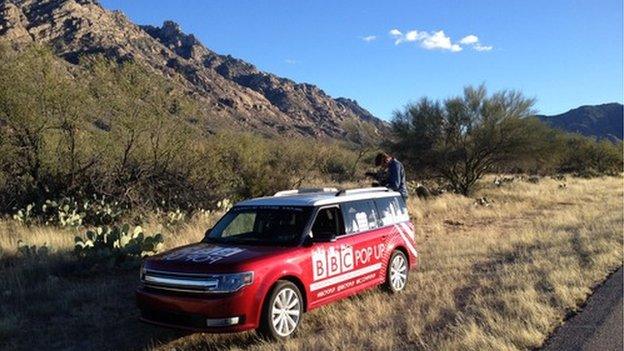
Just stopping to smell the cactuses
As the sun was starting to set we stopped to photograph a row of postboxes along the side of the road.

As we were standing there admiring the views, one of the postbox owners pulled up to collect his mail. We asked about how far down the side road we would be able to drive. The mailbox owner smiled and suggested that we drive down to a bar with a dirt floor in some place called Cowtown something-or-other.
Since I arrived in Tucson, I have been poring over guidebooks about Tucson and Arizona. I have also researched almost every attraction listed on RoadsideAmerica.com that is within an hour of Tucson. But I haven't read a thing about anyplace called Cowtown.
Eager to find out what and where Cowtown was, we headed down the gravel road. We drove a few miles and sure enough, there was a sign with an arrow for Cowtown Keeylocko.
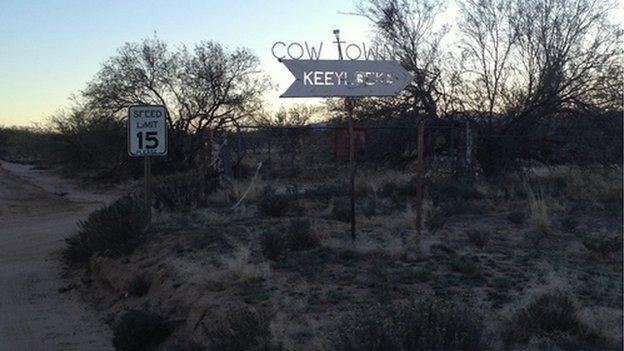
It's a sign…that we are headed somewhere
We kept following the signs and quickly ended up in a place where even the GPS didn't know there was a road.
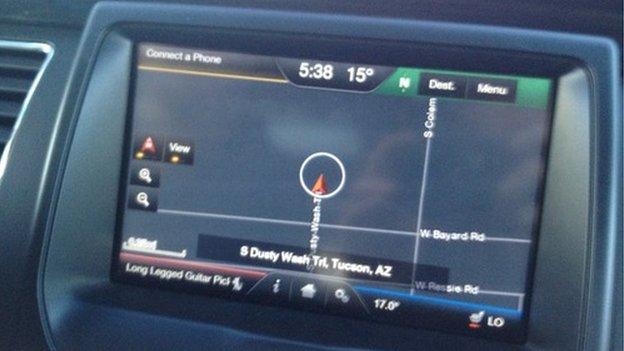
A few more turns down an increasingly dusty dirt road and we arrived at Cowtown Keeylocko - which at this point in the day was completely deserted. Except for this guy…
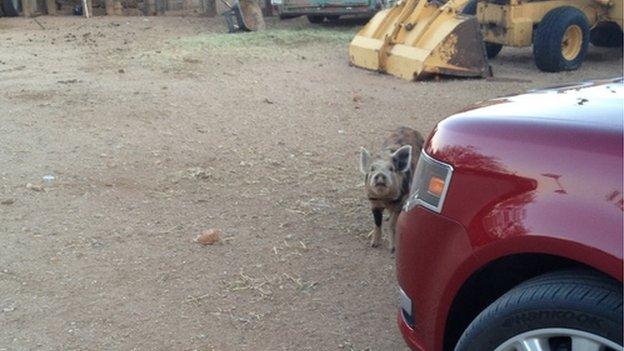
Welcome to Cowtown Keeylocko
We stepped out of the car to a loud moo from a big cow and we were soon welcomed by several more pigs.
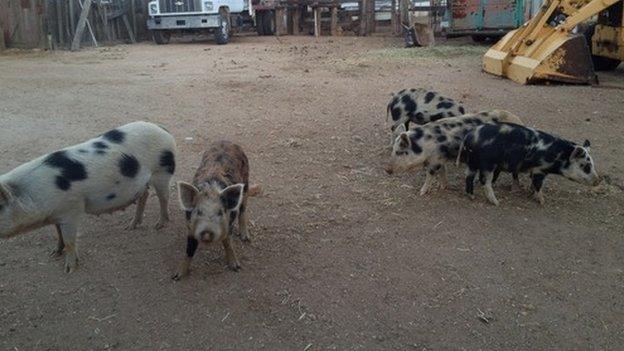
Cowtown Keeylocko welcoming committee
From what we pieced together from a 2010 Los Angeles Times article, external and a 1997 Tucson Weekly article, external, we learned that Cowtown Keeylocko is a fictional town that was created by a cowboy named Ed Keeylocko. Mr Keeylocko owns a working ranch and started building his own town back in the '70s. The town has a library, a general store, a bank, a cemetery and saloon.
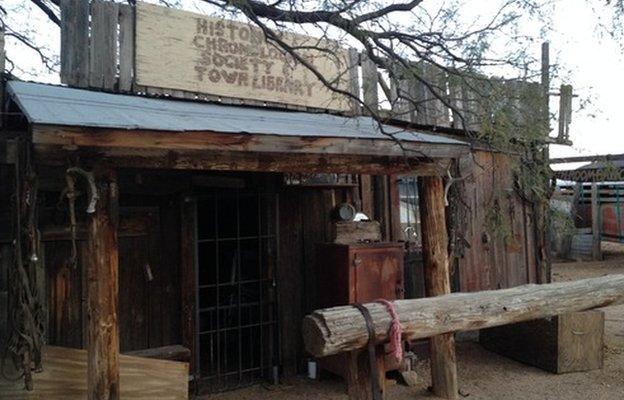
The Cowtown Keeylocko Town Library
The local watering hole for Cowtown Keeylocko is the Blue Dog Saloon.
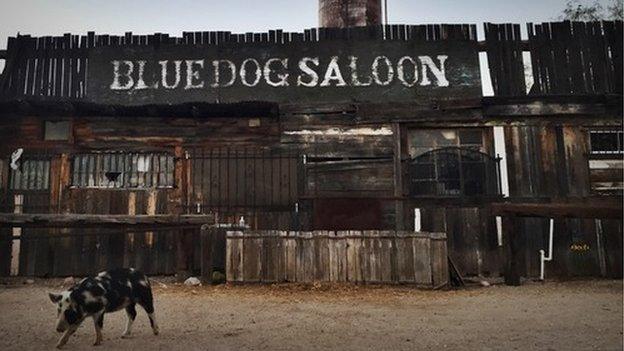
A view of the side of the Blue Dog Saloon
The Blue Dog Saloon has a liquor licence and is apparently open some of the time.
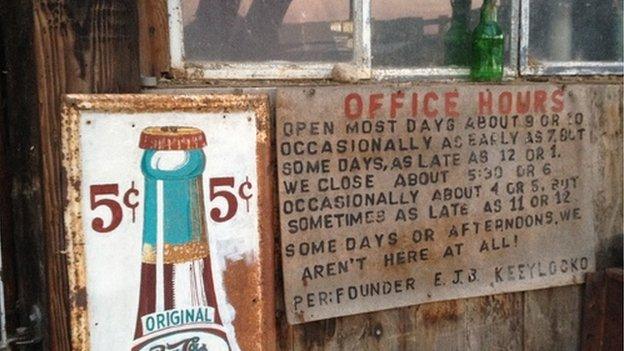
The hours for the Blue Dog Saloon
Since the sun was setting and the Blue Dog wasn't open, we decided to mosey on back to the main road and head into to town.

The sun sets on Cowtown Keeylocko
It was well after dinner time, so we pulled over for a bite to eat at Cindy Lou II's, which is one of the only places to stop along Highway 86 between Cowtown Keeylocko and Tucson. I highly recommend the green chili omelet.

Green chili omelet from Cindy Lou II's, Tucson, Arizona
How to get to Cowtown Keeylocko:
If you are looking to visit Cowtown Keeylocko, check out the Cowtown Keeylocko Facebook, external.
Don't try to use Google maps to get there - we can assure you that the roads aren't listed. Take highway 86 west from Tucson to Hayhook Ranch Road (near mile marker 146). Turn down Hayhook Ranch Road and follow the signs to Cowtown Keeylocko.
We are still trying to figure out when the Blue Dog Saloon will be open next. Hopefully we will get to visit again before we leave Tucson.

Roadside Arizona: A Stop at Rooster Cogburn's Ostrich Ranch
27 January 2015
Just north of Tucson in the town of Picacho, Arizona, is Rooster Cogburn's Ostrich Ranch. We learned about this establishment from the Roadside America app and decided to make a stop on our way to the Grand Canyon.
There is a lot more to see than ostriches at Rooster Cogburn's Ostrich Ranch. The ranch was founded by DC Cogburn. There was a famous character from the novel and movie True Grit named Rooster Cogburn, so DC Cogburn was referred to as Rooster. That is how the ranch got its name.
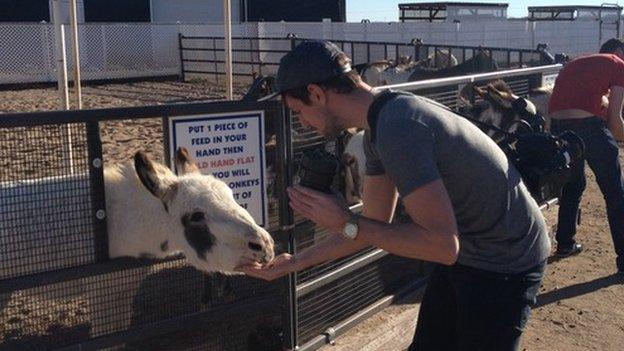
Little Donkeytown USA
We had the chance to meet and feed some donkeys, deer, ostriches, prairie dogs, ducks and lorikeets.
We all agreed that the donkeys were the friendliest animals at the ranch (at least they were the ones that we were least afraid to stand in front of for a photo).

Matt and Ben pose for a photo with the deer at Rooster Cogburn's Ostrich Ranch
The ostriches are really fascinating creatures with long skinny necks…
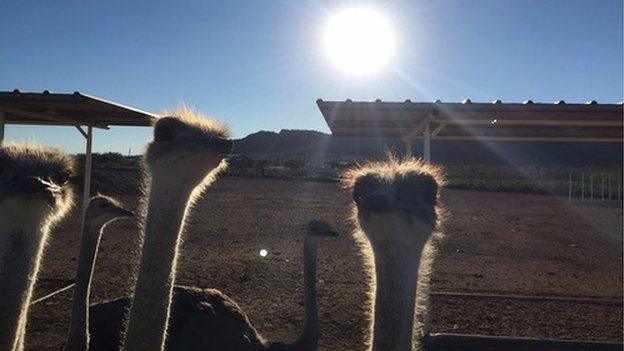
Well, hello there
...who also has long legs and some interesting looking feet.
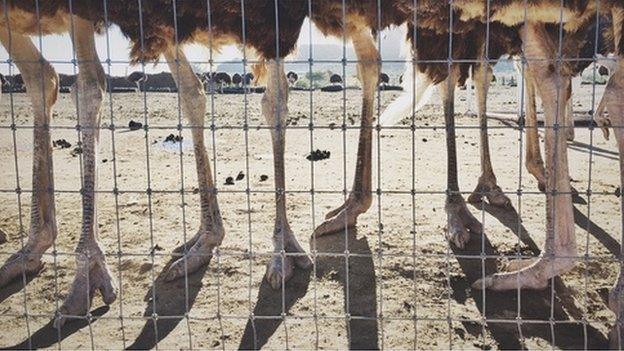
Look at those legs
Rooster Cogburn's hands you a small cup of nectar and sends you into a giant bird cage to meet the lorikeets.
The birds landed on us so quickly we barely had time to get the camera out. Thankfully, Ben was able to snap this selfie while the bird was perched on his head.
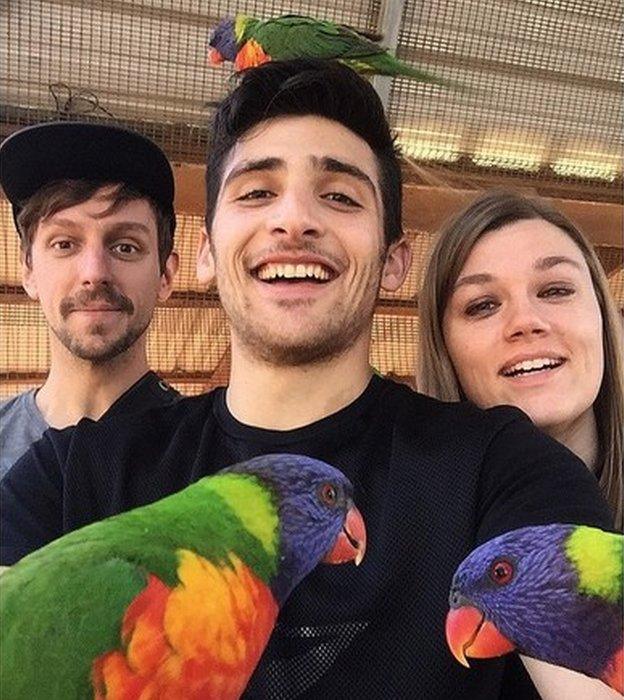
The BBC Pop Up Team meets the Lorikeets
Rooster Cogburn's Ostrich Ranch is open 7 days a week from 9am - 5pm.
Looking for more ostrich events? Head to Chandler, Arizona in March for the 27th annual Ostrich Festival.

23 January 2013
Trailer talk - tell us your stories of life in a mobile home park
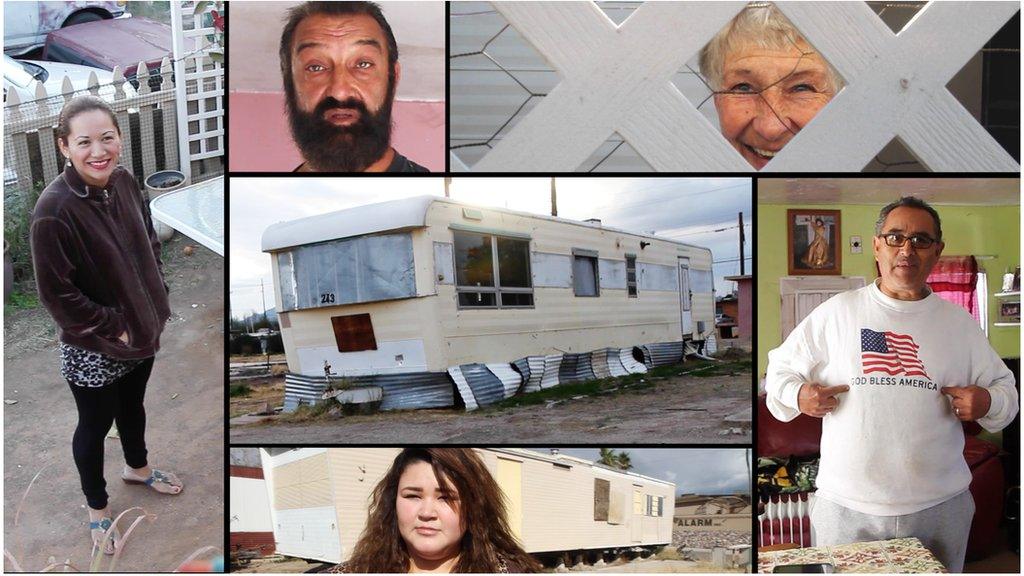
Pop Up's month in Arizona coincides with the launch of the BBC's A Richer World series. While the global elite gathered in Davos to discuss inequality, we wanted to see what was happening on the ground in Tucson.
Arizona was one of the US states hit hardest by the financial crash and the subsequent collapse of the housing market. Many people lost their homes and ended up in one of the scores of trailer parks dotted around this desert city.
At the Sleepy Hollow Trailer Park, BBC video journalist Anna Bressanin met residents who defied the negative stereotypes of trailer park life. You can watch her video and read her blog post below.
An estimated 20 million people live in mobile homes across the US. Tell us your stories - good and bad - about what it's like.
Pop-Up visits Tucson's Sleepy Hollow Trailer Park

How hard can it be to film in a trailer park?
The first challenge, in Tucson, Arizona, is that there are too many trailer parks.
I wanted to focus on one single place to be able to spend all my time there and gain a deeper look into the life of the residents. But how to choose between over 200 mobile home parks and more than 17,000 trailers?
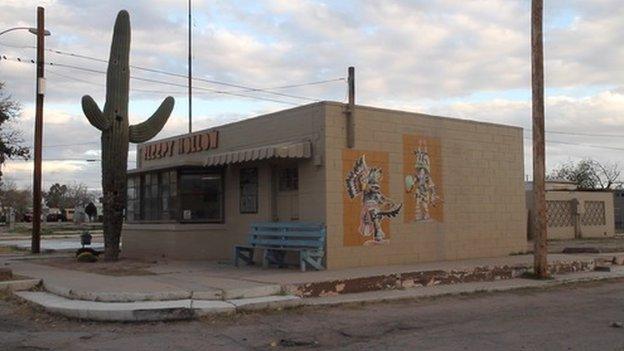
Sleepy Hollow office
I decided to film at Sleepy Hollow because it is a park that dates back to the 1940s. Local media had described it as being in very poor condition (thank you for the all tips @EmilyBregel!). It also helped that the manager, Dennis Huggil, answered the phone right away.
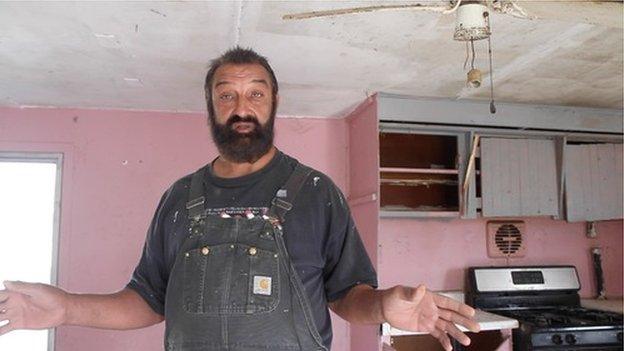
Sleepy Hollow manager Dennis Huggil showing me the trailer of the former manager
Most of the residents didn't want to talk on camera or let me film inside their trailers. The manager gave me a list of trailers were I might find someone who would talk to me. In the end, I just hung around long enough and knocked on various doors until I started to meet people who even already knew that "someone was making a movie".

The list of trailers where residents might be willing to talk
The people I interviewed were very friendly and mostly optimistic about the future. Some were big believers in the American Dream and its promise that through hard work they could achieve a better life.

Melissa, 19, is a high school student who wants to become a make-up artist
Crime is an issue in the neighbourhood - police reported eight incidents in the area while I was there - but it never felt unsafe during the day.

Filming inside a trailer
My only regret: the owner of the trailer park didn't give me an interview. I would have liked to ask him why he doesn't invest more in the park to keep it in better condition.
- Anna Bressanin

21 January 2015
Out and about in Tucson
We've spent a lot of time in Tucson and the nearby area in the past few days.
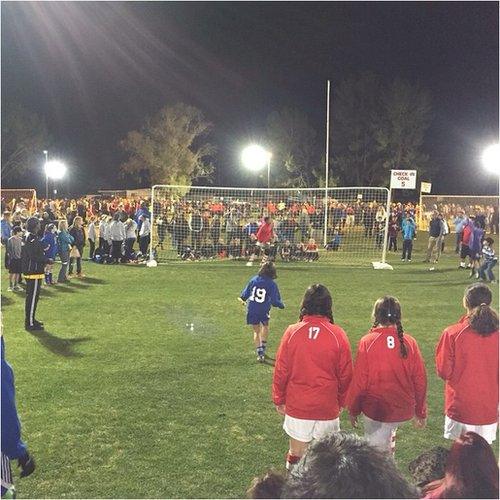
Soccer in the Southwest! We stopped by the opening events for the Fort Lowell Shootout. Sponsored by the Tucson Association of Realtors, this is one of the largest soccer tournaments in the Southwest.

At a breakfast hosted by the Fundacion Mexico where #Tucson City Councilwoman Regina Romero is speaking about how the city is working to be more welcoming to immigrants.
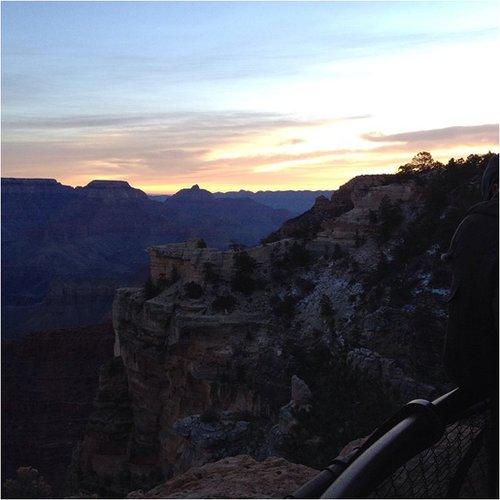
We arrived at the south rim of the Grand Canyon, just in time for sunrise.
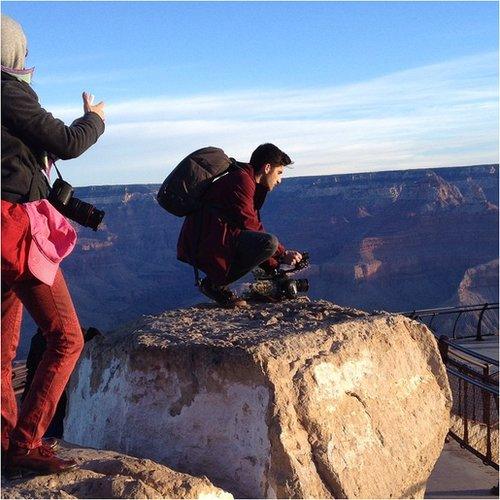
Benjamin Zand capturing some of the splendour of the Grand Canyon...
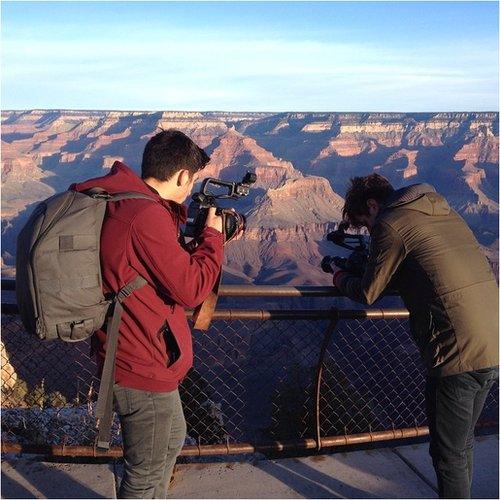
... and of Matt Danzico filming.
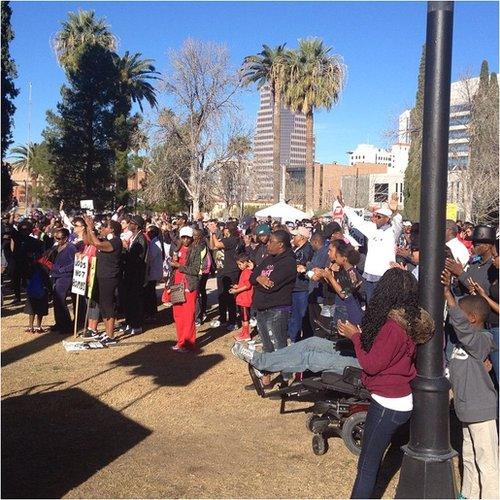
On Martin Luther King Jr day in Tucson, the crowd at Armory Park Center listened to a recording of King's "I have a dream" speech.
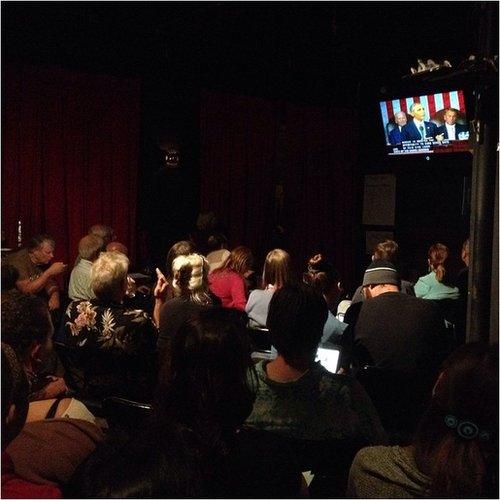
The State of the Union watch party at Hotel Congress in Tucson, Arizona. At least 50 people gathered in the night club space to watch President Obama speak. The State of the Union watch party was organised by the Arizona chapter of Organize for America.
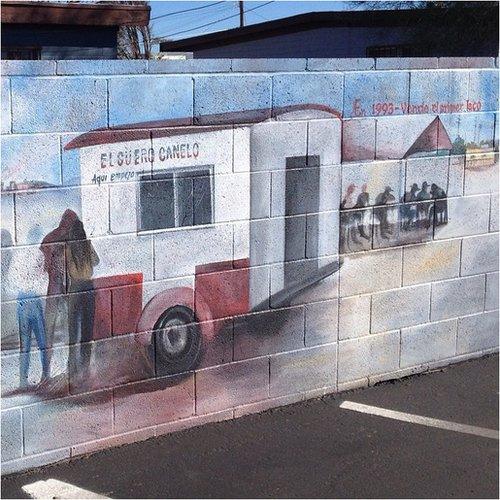
In search of the best Sonora style hot dog we headed to El Guero Canelo for lunch. They have been selling hot dogs in Tucson since 1993. The history of the restaurant is painted on the murals in the parking lot.
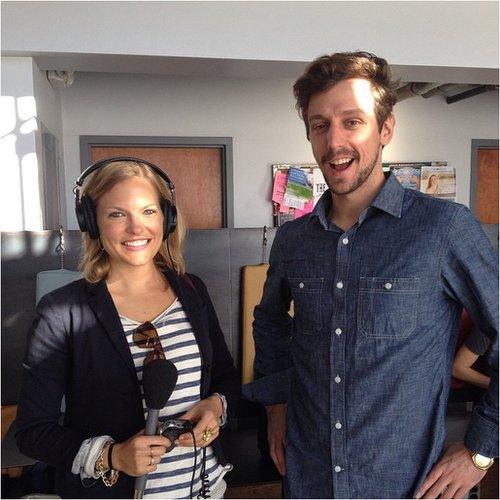
Another great meeting at Sparkroot coffee shop this morning. Vanessa Barchfield from Arizona Public Media gave us the lowdown on cycling around Tucson. "Beware of the trolley tracks."

17 January 2015
An introduction to Tucson
Hello, Arizona! We arrived in Tucson last weekend and headed out to the Heirloom Farmers Market at Rillito Park to talk with local residents about what issues matter to them. Here are some of the topics we will be exploring while in Tucson for the month…
immigration and the border
water conservation
issues around Native American land
religion and education
Arizona artists
professional bicycle races
continued revitalisation of downtown Tucson
BBC Pop Up arrives in Tucson, Arizona.
As I type this, Benjamin Zand is on his way to Nogales, Arizona, to learn more about border issues.
We are working out of the Arizona Daily Star offices and have already had a chance to check out some of the best local cuisine with Hipolito Corella, who is one of the editors at the Arizona Daily Star.
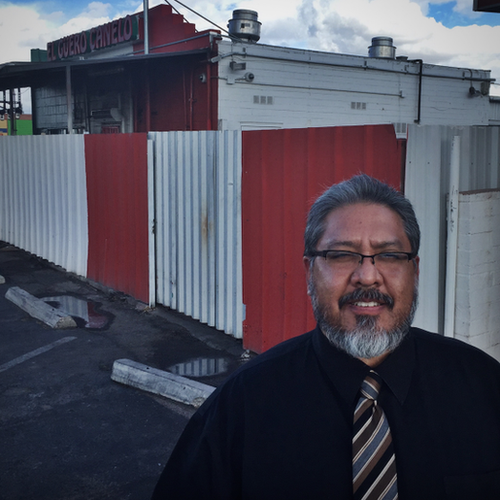
What else should we see and do (and eat) while we are here in Tucson? Send us a tweet @BBCPopUp or email bbcpopup@bbc.co.uk.
- Lindsay Patross, BBC Pop Up Social Media Producer

14 January 2015
Desert fog
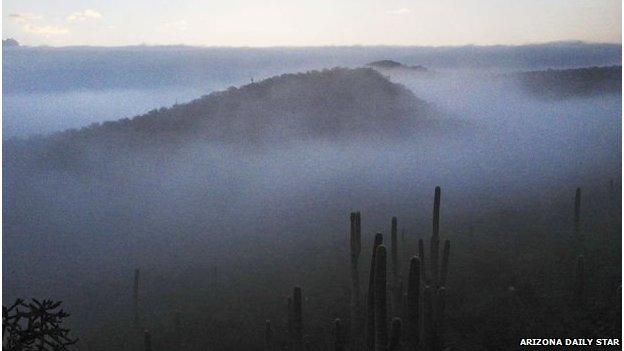
Photo by Mamta Popat
Tucson was buzzing this morning about a fog that set in over this desert city.
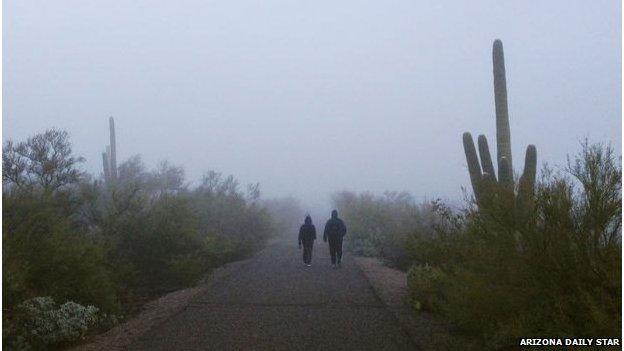
Photo by Mamta Popat
I began receiving Facebook messages at 07:00 MT from area friends telling me to get up and walk around the downtown to see the thick white gas floating about the region.
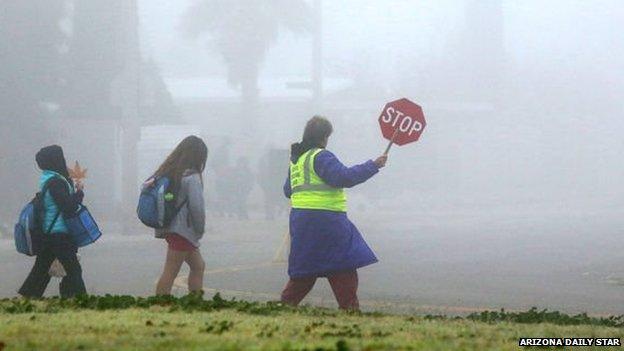
Photo by AE Araiza
"That's the worst fog I've ever seen here. I can remember bad fog twice in the past 11 years, and that was one of them," says Cathy Horness of the Arizona Daily Star.
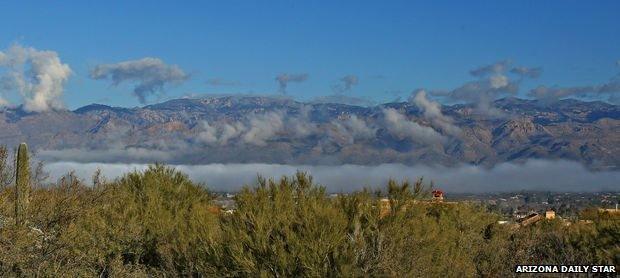
Photo by AE Araiza
The fog was just left over residue from yesterday's rainstorm, but it certainly added a sense of magic to an average daily commute. By the afternoon the traditional blue skies had returned,
See the full photo gallery on the Daily Star's website, external.
- Matt Danzico, BBC Pop Up bureau chief

Office space
This is a behind-the-scenes blog so I wanted to show you the view from my desk in the Arizona Daily Star newsroom - and also to explain where the Pop Up team has been working while on the road.

I did all the planning for this project in pretty much just three months last summer before launch - from logo design to equipment purchase to editorial objectives. During that time, I drafted a booklet that described how each month would operate. I hypothesised that co-working spaces around the US would be the best places from which to work.
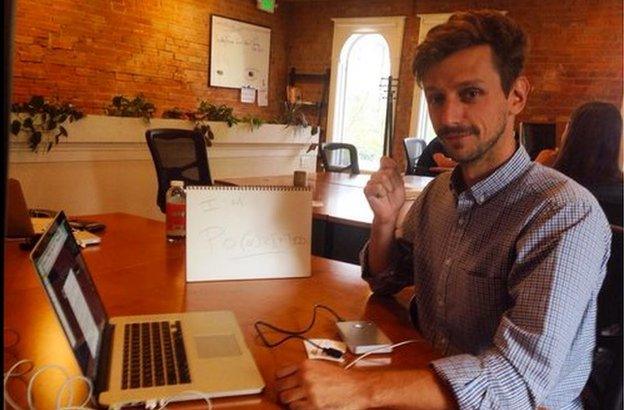
A co-working space in Boulder, Colorado, during our first stop in September
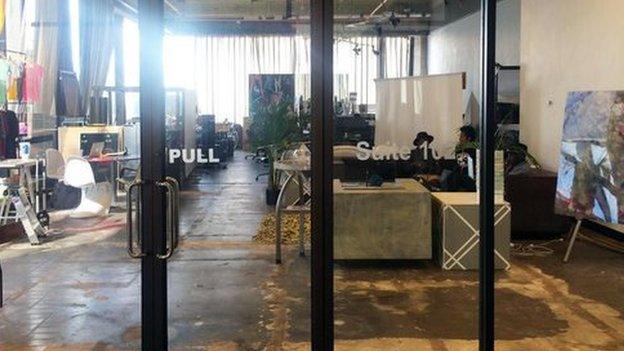
A co-working space in Baton Rouge, Louisiana, where we based ourselves in October
I thought that by basing the BBC Pop Up team with the tech-minded, early adopters who inhabit such spaces, we'd set ourselves up to stew in the innovative enthusiasm typically found there. And so we set off. We worked in co-working spaces in Boulder and Baton Rouge. The people we spoke with remain some of the most interesting individuals we have met on the trip. Our office comrades, many of whom were designers, programmers or entrepreneurs, were very excited to have journalists in the office. They tweeted about our projects to their audiences, often swung by to speak with us and even invited us to happy hours.
But for exactly the same reasons that these spaces were fantastic, they were also not the right fit. Co-working spaces often serve as networking locales as well, where freelancers try to find work and like-minded people. To be honest, being among such interesting people was too distracting. We couldn't resist speaking to our office mates all day long.

The Argus Leader newspaper in Sioux Falls, South Dakota, where we were based in December
So for the past three months, we've taken refuge at local newspapers (I'm really not sure why working out of local newspaper offices didn't strike me when designing the project). We have been equally inspired by those around us - and they also know their cities inside out so are a great source of advice. The big difference is we're rubbing elbows with professionals grappling with the same struggle as us: how to find a story, focus on it and get it finished before a deadline.
We'll see where we work in the next and last location, but it might be interesting to try something different once again. Any suggestions?
Until then, I must get back to work.
For past stories from South Dakota and other previous locations, visit BBC.com/popup.
- Matt Danzico, BBC Pop Up bureau chief

12 January 2015
Flying into Tucson
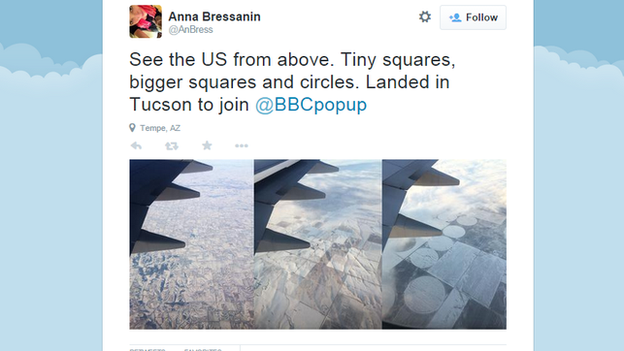
At the OK Corral
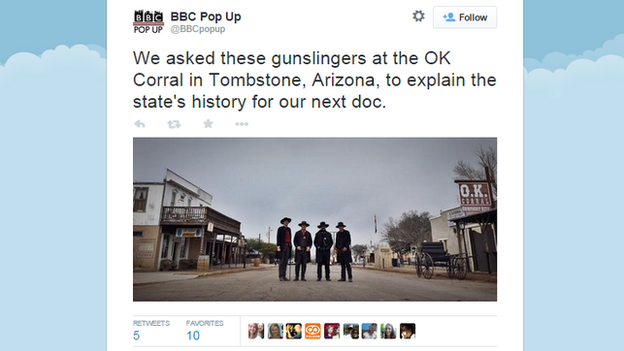

Flying high over Arizona
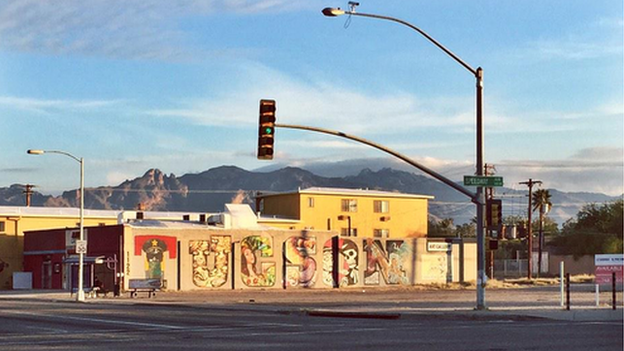
[Written on Saturday, 10 January, prior to landing in Arizona]
…And we're off to the American Southwest.
For the next several weeks, BBC Pop Up will be based in Tucson, Arizona, a hot, arid landscape known for desert, cacti and immigration debates. Having just left South Dakota, where the air temperature is cold enough to freeze the ears off a donkey (-2F last I checked), it'll be a much needed change.
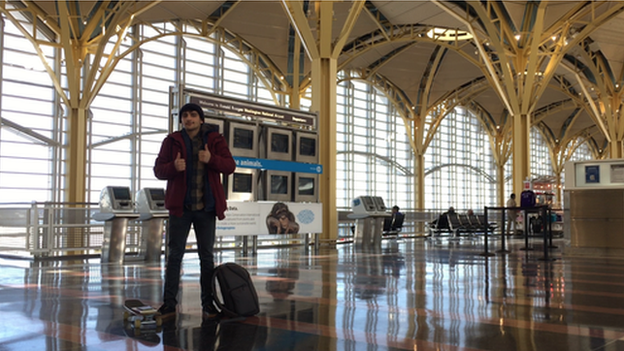
Ben standing in an airport in Washington DC, where we stopped for a few days between cities
Benjamin (pictured) and I are flying this time, leaving our trusty steed Ruffous Motmot in the frigid hands of the Sioux Falls airport parking lot. If you see Ruffous, please tell him to hold tight. We had to leave him behind simply due to logistics and dates.
When we do collect Mr Motmot, the BBC's US social media editor Glenn Anderson has promised to help me with the 22-hour drive from South Dakota to Arizona (yes, I'm holding you to it, Glenn).
Should he get caught up in the news cycle I may need an alternative travel companion. Anyone interested? That's a serious request. If interested, tweet #bbcpopupdrivingbud.
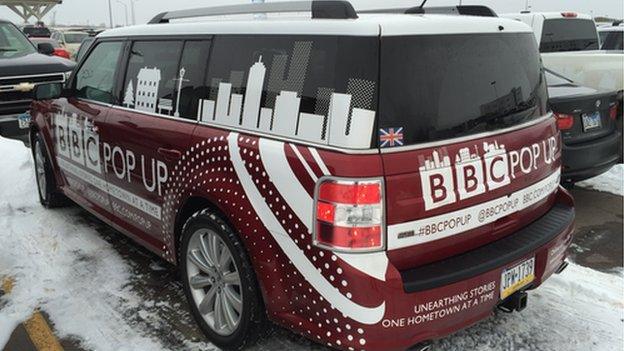
Ruffous Motmot sitting in a parking lot in Sioux Falls
The only hitch we've experienced so far has come while booking housing in Arizona. During the four months on the road so far we've been using various websites to find accommodation. I did the same a few days before hopping on the flight from which I write this.
But last night, I received an email from an editor at The Arizona Daily Star, who told me the house we booked is in a neighbourhood known for "burglary and small-time drug deals".
We quickly cancelled our accommodation and have instead found refuge at a motel that looks as if it was part of a 1980s Coen brothers film set.
It's the type of place one might imagine men with thick moustaches and gold chains frequent. But I just bought a fake gold watch, so I'll fit in perfectly. Benjamin on the other hand will have to sleep in the parking lot.
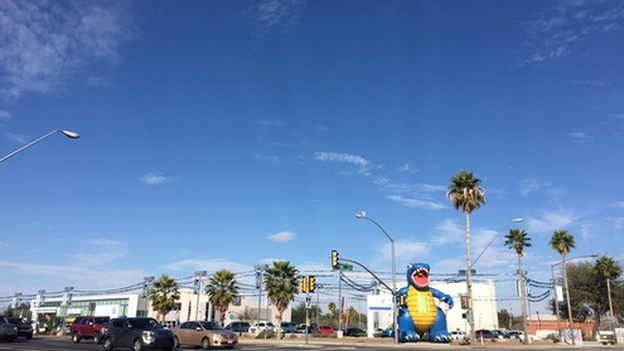
A corner in Tucson, Arizona
We're very excited about this stop. About 50% of those we speak to on the telephone from Tucson warn us about a gem festival that will "pinch the city".
I'm still not entirely sure what they're speaking about, but from what I've gathered a large rock convention is taking place downtown in a week or so. It's expected to draw hundreds of thousands of geology experts, jewellers and hobbyists.
Other events, happenings and sites we've heard about include an airplane graveyard that houses thousands of decaying planes, the OK Corral and professional bicycling trails.
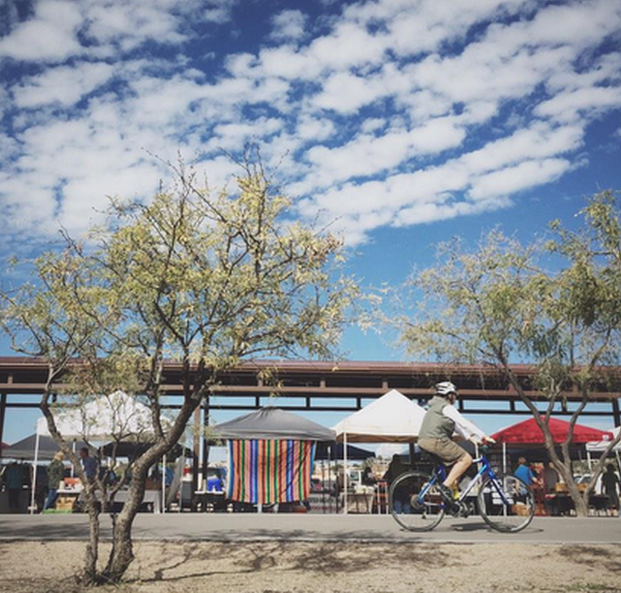
A farmers market in Tucson
When we first arrive, we're going to hit the mean streets of Tucson to ask Arizonians what stories they'd like us to cover while we're in the region. We are there, after all, to crowdsource story ideas from local residents and make short documentaries about the issues they suggest.
We will attend a farmers market tomorrow morning. We'll stop shoppers to see what they'd like us to cover. We're then hoping to travel an hour south to the OK Corral the following day, where we'll stop locals for story suggestions as well.
Okay, now for some shuteye. Things are bit cramped on this flight. And if I've learned anything about air travel in the past decade of being a journalist, it is that pounding away on a keyboard invades others' personal space. And right now, I think I'm staging elbow assaults to the east and west of me.
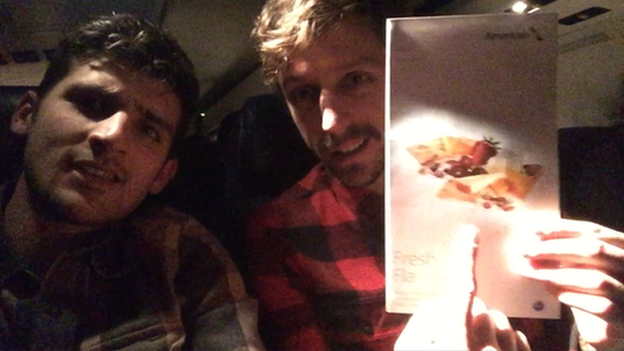
Benjamin and I sitting on a flight to Tucson
For past stories from South Dakota and other previous locations, visit BBC.com/popup.
- Matt Danzico, BBC Pop Up bureau chief